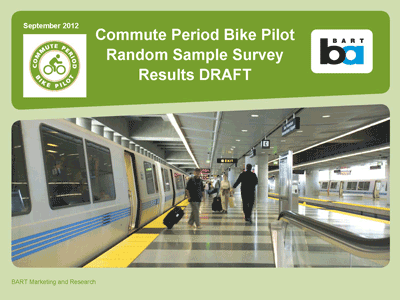BART releases bike pilot survey results; any proposed changes need to go to Board

Cover page of survey results
A rider survey about BART’s commute period bike pilot, when blackout restrictions were lifted on five Fridays in August, found varied results.
Currently, there are bike blackout periods of about two hours during peak weekday commute times in which bikes are not allowed on some trains. Any proposed changes would need to go to the Board of Directors for consideration.
Riders responding to the survey were equally split on what to do: 37% wanted to keep the blackouts; 37% wanted to end them; and 25% favored reducing the blackout periods to one hour from two. Other data from the survey suggest similarly divided feelings.
Findings tending to support eliminating the blackouts included:
- 90% of respondents aware of the pilot who rode during the commute reported they did not personally experience any problems related to it. (Of the 10% who did experience problems, the most commonly cited problems were bikes blocking aisles, doorways and seats; bikes entering crowded trains; and bikes running into or brushing up against people.)
- When asked if lifting the blackout would impact their likelihood to ride BART, 25% said they would be more likely to ride. (10% would be less likely to ride and 66% would be equally as likely to ride.) “Interestingly, almost half the respondents skipped this question, which could mean that they were not sure of the answer (unable to anticipate if they would change their behavior or simply thought allowing bikes would have no impact on their likelihood to ride BART)” the survey states.
Findings tending to support retaining the blackouts included:
- Asked how lifting the blackout affected their BART trip, 17% said it made their trip worse. (9% said it made their trip better, and 74% said it had little or no effect.).
- Almost a quarter of respondents who rode during the pilot indicate that, even with the current rules, there is poor compliance. Significant percentages said rules are “rarely” or “never” followed with regard to: bikes blocking aisles or doors (24%); bikes entering crowded trains (22%); bikes yielding priority space to seniors and people with disabilities (17%); bikes on escalators (18%).
“The survey results provide valuable insights into the experience of BART riders, both cyclists and non-cyclists, during the pilot. This information will guide the discussion as we move forward” said BART Bike Program Manager Steve Beroldo. The results were discussed in a debriefing session with BART staff, the BART Accessibility Task Force, BART Bicycle Task Force, and the SF and East Bay Bike Coalitions on Sept. 26.
For information on methodology of the survey and to review the complete results, download the BART Marketing and Research Survey (.pdf) presented on Sept. 26.
The public will have an opportunity to discuss the results when the BART Bicycle Task Force has a meeting on Monday, Oct. 1, at 6 pm.
The pilot program also provided valuable lessons on how BART can better accommodate bikes during the busy commute periods. Some areas under consideration include:
- Reconfiguring car interiors to create more space for items with wheels (i.e. bikes, wheelchairs, strollers). This project is ongoing but may be accelerated.
- Embarcadero Station, because of its narrower platform and limited vertical circulation, may present a challenging situation for bikes during the commute period and it might be better to encourage bikes to use nearby Montgomery Station.
- Allowing bikes on the narrow lower platforms at 12th and 19th in Oakland may require some direction on how passengers queue to assure good circulation.
- Relaxing restrictions would require additional communication on bike etiquette—(e.g. don’t board crowded train, what to do if train becomes crowded, use stairs and elevators not escalators, yield to elderly/disabled, etc.). This could take the shape of an ongoing informational campaign.
- Making train specific load factor data available in a user friendly format (e.g. as part of the bart.gov trip planner). This will have dual benefits: (1) help bicyclists find the least crowded trains and (2) spread the load overall creating additional “capacity” for all passengers.
The bike survey is now closed. Feedback on any BART issue may be given through BART’s comment form at: www.bart.gov/comments